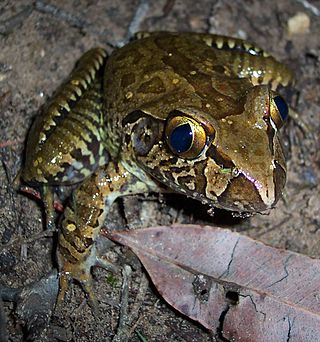
Conondale National Park is 130 km north of Brisbane in the Sunshine Coast Hinterland near the town of Conondale in the south east Queensland bioregion. The park covers an area of 35,648 hectares protecting large areas of subtropical rainforest, woodlands, wet and dry sclerophyll forest including Queensland's tallest tree. The park contains areas of regenerating forest which have been previously logged; areas of forest plantations also border the park. The park is currently managed by the Queensland Government under the Nature Conservation Act 1992.

Eungella National Park is a protected area in Queensland, Australia. It is on the Clarke Range at the end of the Pioneer Valley 80 km west of Mackay, and 858 km northwest of Brisbane. Eungella is noted for the national park which surrounds it. It is considered to be the longest continual stretch of sub-tropical rainforest in Australia. The original inhabitants are the Wirri people. The park is covered by dense rainforest and is known for its platypuses.

Threatened fauna of Australia are those species and subspecies of birds, fish, frogs, insects, mammals, molluscs, crustaceans, and reptiles to be found in Australia that are in danger of becoming extinct. This article lists species classified as threatened species under the Commonwealth Environment Protection and Biodiversity Conservation Act 1999.
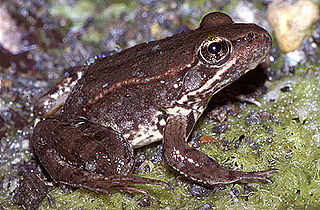
The California red-legged frog is a species of frog found in California (USA) and northern Baja California (Mexico). It was formerly considered a subspecies of the northern red-legged frog. The frog is an IUCN near-threatened species as of 2021, has a NatureServe conservation status of Imperiled as of 2015, and is a federally listed threatened species of the United States that is protected by law.
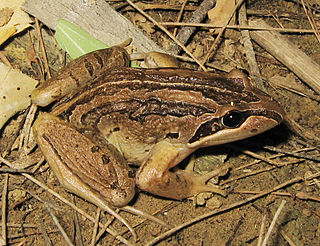
The striped marsh frog or brown-striped frog is a predominantly aquatic frog native to coastal Eastern Australia. It is a common species in urban habitats.

Taudactylus is a genus of frogs in the family Myobatrachidae. These frogs are endemic to rainforest areas of coastal eastern Australia, most of this genus inhabit fast flowing streams in highland area. Most members of this genus have suffered serious declines, in which the disease chytridiomycosis appears to have played a significant role: T. diurnus is believed to be extinct, while all others except T. liemi are listed as critically endangered by the IUCN. These listings are conservative, and it is likely T. acutirostris, presently listed as critically endangered, already is extinct.

Rheobatrachus, whose members are known as the gastric-brooding frogs or platypus frogs, is a genus of extinct ground-dwelling frogs native to Queensland in eastern Australia. The genus consisted of only two species, the southern and northern gastric-brooding frogs, both of which became extinct in the mid-1980s. The genus is unique because it contains the only two known frog species that incubated the prejuvenile stages of their offspring in the stomach of the mother.
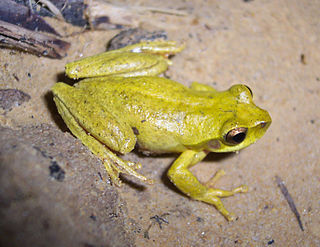
The revealed frog, whirring tree frog, or orange-thighed treefrog is a species of tree frog native to coastal eastern Australia.
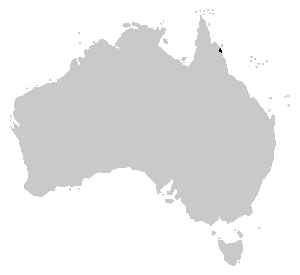
The armoured frog, or armoured mist frog, is a species of tree frog in the torrent frog complex, a group restricted to north-eastern Queensland, Australia.

Amphibians of Australia are limited to members of the order Anura, commonly known as frogs. All Australian frogs are in the suborder Neobatrachia, also known as the modern frogs, which make up the largest proportion of extant frog species. About 230 of the 5,280 species of frog are native to Australia with 93% of them endemic. Compared with other continents, species diversity is low, and may be related to the climate of most of the Australian continent. There are two known invasive amphibians, the cane toad and the smooth newt.

The Eungella torrent frog or Eungella day frog is a species of stream dwelling frog endemic to Australia. It is restricted to ranges west of Mackay in mid-eastern Queensland.
The Cooloola sedge frog or Cooloola tree frog is a species of frog in the subfamily Pelodryadinae.
The mountain mist frog or Nyakala frog was a species of frog in the subfamily Pelodryadinae, endemic to Australia. Its natural habitats were subtropical or tropical moist lowland forests and rivers. It was threatened by habitat loss and potentially chytrid fungus, before being declared extinct in 2022.
The sharp snouted day frog, or sharp-nosed torrent frog, is an extant species of frog in the family Myobatrachidae. It is endemic to upland rainforest streams in north-eastern Queensland in Australia.
The Mount Glorious day frog, also known as Mount Glorious torrent frog and southern day frog, is an extinct species of frog native to south-east Queensland. It has not been recorded in the wild since 1979.

The Eungella tinker frog, also known as Eungella tinkerfrog, Liem's frog, or Liem's tinker frog, is a species of frog in the family Myobatrachidae. It is endemic to the Eungella area in Queensland, Australia. It lives in rocky margins of fast-flowing creeks and seepages in montane rainforest at elevations of 180–1,250 m (590–4,100 ft) above sea level, but it is more common above 600 m (2,000 ft). It is commonly heard but rarely seen. In contrast to other amphibians in the area, such as Taudactylus eungellensis, no adverse effects of the chytrid fungus Batrachochytrium dendrobatidis have been reported on this species. It is currently facing no major threats, although its habitat could be impacted by grazing and trampling of streamside vegetation by livestock. Also invasive cane toads are a potential future threat. Its range is with the Eungella National Park.
The Kroombit tinker frog, also sometimes referred to as Pleione's torrent frog, is a species of frog in the family Myobatrachidae. It is endemic to Central Queensland in Australia. It lives among rocks and leaf litter near small flowing streams.

The southern corroboree frog is a species of Australian ground frog native to southeastern Australia.
Rheobatrachus vitellinus, commonly called northern gastric-brooding frog, is an extinct species of gastric-brooding frog native to Australia.











